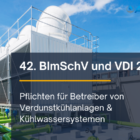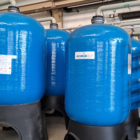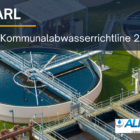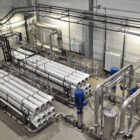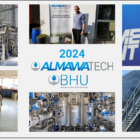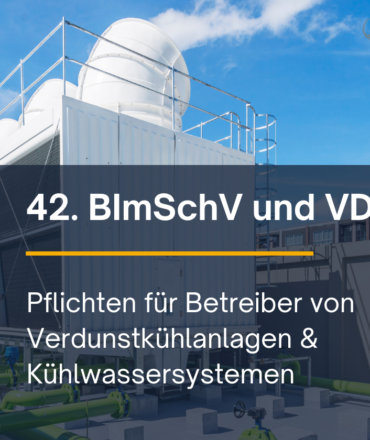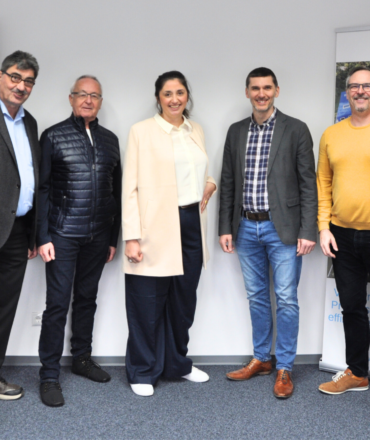The operation of evaporative cooling systems, cooling towers and wet separators entails a high level of responsibility, particularly with regard to the protection of the environment and human health. The 42nd BImSchV (42nd Federal Immission Control Ordinance) and the VDI 2047 (guideline of the Association of German Engineers) are the central regulations in Germany to ensure the safe operation of such systems and to minimize the risk of legionella spreading. In this article, we explain what these regulations contain, why they are important and what operators need to bear in mind.
Table of contents
The 42nd BImSchV - Legal requirements for operation
The 42nd BImSchV regulates the operation of evaporative cooling systems, cooling towers and wet separators. It came into force in 2017 and aims to prevent the spread of waterborne aerosols - in particular legionella - into the atmosphere. Legionella are bacteria that can cause serious lung diseases, such as Legionnaires' disease, via inhaled aerosols.
Obligations for operators in accordance with the 42nd BImSchV:
1. duty of disclosure:
Every evaporative cooling system, cooling tower or wet separator must be reported to the competent authority. This obligation applies not only to the commissioning of new systems, but also to:
Changes to existing systems (e.g. technical conversions or extensions).
Decommissioning or final decommissioning of the system.
The notification must contain all relevant information, such as location, technical specifications and operating conditions.
2. risk assessment:
Operators are obliged to carry out a risk assessment in order to identify potential risks in connection with the operation of the system. This includes
The assessment of potential sources of danger, such as the proliferation of legionella or other microorganisms.
Identification of weak points in the system that could lead to contamination of the cooling water.
The definition of suitable countermeasures to minimize the identified risks.
The risk assessment must be updated regularly, particularly in the event of changes to the system or the operating conditions.
3. regular review:
Regular inspections are required to ensure that the system is hygienically safe. These include
Technical inspections of the system to ensure its proper operation.
Microbiological testing of the cooling water, in particular for legionella.
The examinations must be carried out at fixed intervals, usually at least every three months.
Sampling and analysis must be carried out according to recognized standards to ensure reliable results.
4. documentation obligation:
Operators are obliged to fully document all relevant operating and maintenance measures. This includes
Protocols of the risk assessments and their updates.
Results of the microbiological tests of the cooling water.
Maintenance and cleaning work carried out on the system.
Measures taken to minimize risks as a result of the risk assessment or if limit values are exceeded.
The documentation must be kept for at least five years and must be available to the competent authority on request.
5. obligation to react if limit values are exceeded:
If the legally prescribed legionella limit value in the cooling water is exceeded, operators must act immediately. The necessary measures include
Immediate notification of the competent authority that the limit value has been exceeded.
Determining the cause of the contamination.
The implementation of countermeasures, such as intensified cleaning and disinfection of the system.
The renewed microbiological examination of the cooling water to check the effectiveness of the measures.
The response obligation serves to minimize the risk of legionella spreading and the associated health hazards as quickly as possible.
Why is the 42nd BImSchV important?
Compliance with the regulation serves to protect public health and the environment. At the same time, it protects operators from legal consequences such as fines, official requirements or, in the worst case, the shutdown of the plant.
VDI 2047 - Practical implementation of hygiene standards
VDI 2047, specifically Sheet 2, supplements the 42nd BImSchV by providing detailed technical and operational specifications for the hygienic operation of evaporative cooling systems. While the 42nd BImSchV formulates legal requirements, VDI 2047 provides practice-oriented recommendations.
Core contents of VDI 2047:
1. technical design:
VDI 2047 provides clear recommendations for the hygienic design of evaporative cooling systems. These include
Choice of materials: Use of corrosion-resistant and easy-to-clean materials to prevent the colonization of microorganisms.
Design principles: Design of the system to minimize dead zones where water could accumulate and microorganisms could multiply.
Flow optimization: Ensuring an even flow to prevent deposits and stagnation.
These measures help to reduce the risk of microbial contamination as early as the planning and construction phase.
2. operation and maintenance:
Safe and hygienic operation of evaporative cooling systems requires regular maintenance and cleaning measures. VDI 2047 recommends:
Regular cleaning and disinfection: Systematic cleaning of the system to remove biofilms, deposits and microorganisms.
Stable water chemistry: control and adjustment of water quality to prevent corrosion and deposits. This includes monitoring the pH value, conductivity and chemical additives.
Maintenance plans: Creation of and adherence to detailed maintenance plans to ensure the long-term functionality and hygiene of the system.
3. hygienic monitoring:
VDI 2047 sets out clear specifications for the hygienic monitoring of evaporative cooling systems. These include
Regular monitoring of water quality: carrying out microbiological tests, in particular for legionella and other potentially pathogenic microorganisms.
Action plans in the event of anomalies: Detailed specifications in the event that limit values are exceeded or other hygiene problems occur. This includes the immediate initiation of cleaning, disinfection and sanitation measures.
Documentation: Complete documentation of all monitoring and maintenance measures in order to be able to prove compliance with the directive.
4. minimization of health risks:
A central aim of VDI 2047 is to avoid health risks that can arise from the operation of evaporative cooling systems. This includes
Reduction of contaminated aerosols: Measures to minimize the release of aerosols that could potentially contain pathogens such as Legionella. This includes the optimization of the system design and the use of aerosol separators.
Modern technologies: Use of innovative technologies to reduce the colonization and multiplication of microorganisms. Examples include UV disinfection, ozone treatment and biological inhibitors.
Staff training: Ensure that the operating staff have the necessary knowledge and skills to operate the system in a hygienic manner.
Interaction of 42nd BImSchV and VDI 2047
The 42nd BImSchV provides the legal framework, while VDI 2047 offers practical recommendations for concrete implementation. Together, they form a comprehensive basis for ensuring the safe and legally compliant operation of evaporative cooling systems.
Important differences:
- 42nd BImSchV: Binding legal requirements with a focus on notification, monitoring and documentation obligations.
- VDI 2047: Technical and organizational recommendations for implementing the legal requirements and optimizing system operation.
What are the consequences of non-compliance?
Non-compliance with the 42nd BImSchV can have serious consequences, including
- Fines for breaches of reporting or documentation obligations.
- Official requirements such as retrofitting or extraordinary inspection of the system.
- Shutdowns in the event of repeated or serious defects.
- Liability in the event of health hazards, such as the spread of legionella.
Measures for compliance with the 42nd BImSchV and VDI 2047
In order to comply with the requirements of the 42nd BImSchV and VDI 2047, operators of evaporative cooling systems, cooling towers and wet separators should take the following measures:
- Regular maintenance and cleaning:
Thorough cleaning and disinfection of the systems prevents the colonization of microorganisms and reduces the risk of legionella infestation. Deposits and biofilms should be removed regularly. - Continuous water monitoring:
Operators should continuously monitor the water quality. This includes chemical and microbiological analyses, in particular regular testing for legionella, total bacterial count and other indicators. - Creation of a risk assessment:
The identification of potential risks, such as dead zones or insufficient water circulation, forms the basis for targeted optimization measures. - Optimization of water chemistry:
Correct treatment of the circulation water, including pH value control, prevention of limescale deposits and corrosion protection measures, is crucial for safe operation. - Modernization of systems:
The use of modern technology such as UV disinfection systems, droplet separators or optimized cooling systems reduces the emission of aerosols and minimizes hygiene risks. - Staff training:
Qualified and trained staff are essential in order to operate the systems correctly, carry out maintenance work and recognize anomalies at an early stage. - Documentation and reporting:
All measures, investigations and results must be fully documented and, if necessary, submitted to the responsible authorities.
By implementing these measures, operators can not only ensure compliance with legal requirements, but also increase operational safety, reduce costs through preventive measures and minimize potential risks to the environment and health.
Conclusion: Focus on responsibility and safety
Compliance with the 42nd BImSchV and VDI 2047 is not only a legal obligation, but also a key contribution to protecting the environment and public health. Operators of evaporative cooling systems, cooling towers and wet separators must consistently implement the requirements in order to minimize hygienic risks and ensure the safe operation of their systems.
With careful planning, regular maintenance and compliance with legal and technical requirements, operators can not only increase operational safety, but also reduce costs in the long term through preventive measures.
How we can support you
As a specialist for water-bearing systems, we support you in complying with the 42nd BImSchV, VDI 2047 Sheet 2 and VDI/BTGA 6044. As a specialist company, we offer comprehensive advice and measures for implementing the legal and normative requirements - from planning hygiene-compliant systems to implementing modern technologies. Contact us to find out more!
Our expert for the proper operation of evaporative cooling systems and cooling water systems:
Mr. Frank Kuntze




